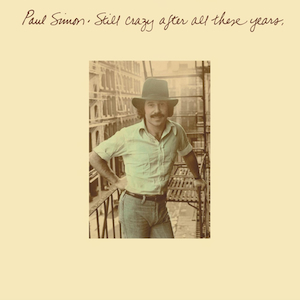The album is front-loaded with some of his best songs, beginning with the resigned title track, its cool electric piano and offbeat strings that perfectly frame the inevitable sax solo. One big draw is “My Little Town”, a reunion on tape with Art Garfunkel (also included on his own concurrently released album). Easily one of their spookier tracks, it nails the feeling of being trapped by one’s origins, heritage, family, society, etc.; in other words, everything that made Simon & Garfunkel spokesmen for their disaffected generation. “I Do It For Your Love” is an extremely melancholy reverie on the ended marriage, finding a metaphor in an odd place, but countered by the jive-rhyme in “50 Ways To Leave Your Lover”, something of a spin on “Love Potion #9”. After four solid tracks, “Night Game” is just plain odd, taking some common baseball expressions literally. It seems out of place here, being more in line with his proper solo debut.
For a big-time mood swing, “Gone At Last” is a gospel raveup sung as a duet with Phoebe Snow and the now-familiar Jessy Dixon Singers whooping it up in back. From there, “Some Folks’ Lives Roll Easy” seems to be way too slow, but manages to keep up with itself, and our warped ears hear influences on and of Van Morrison and Tom Waits of the same period. We don’t have much use for “Have A Good Time”, between the cutesy delivery, broken-legs meter shifts, and particularly the out-of-place sax solo appearing at the end like a busker around a corner in a subway tunnel. “You’re Kind” is much better, by being simple and offering up a twist ending that’s very real. A final mood swing arrives in “Silent Eyes”, a slow, poetic creation, not exactly a prayer, but still establishes a mood of night and sleep. (In an odd bit of foreshadowing, the piano here is played by Leon Pendarvis, whom most casual TV viewers would recognize as a longtime member of the Saturday Night Live band. Thanks in part to his friendship with producer Lorne Michaels, Paul Simon would go on to appear on the show in various capacities many times over the coming decades.)
Such a strong closing track makes Still Crazy After All These Years Paul Simon’s best work since splitting with Artie, and easily on par with the better Simon & Garfunkel albums. (Bonus tracks on the eventual reissue include a demo of a future hit single and a very alternate arrangement of “Gone At Last”.) It must have taken a lot out of him, since his output would be less prolific going forward.
Paul Simon Still Crazy After All These Years (1975)—3½
2004 CD reissue: same as 1975, plus 2 extra tracks

No comments:
Post a Comment